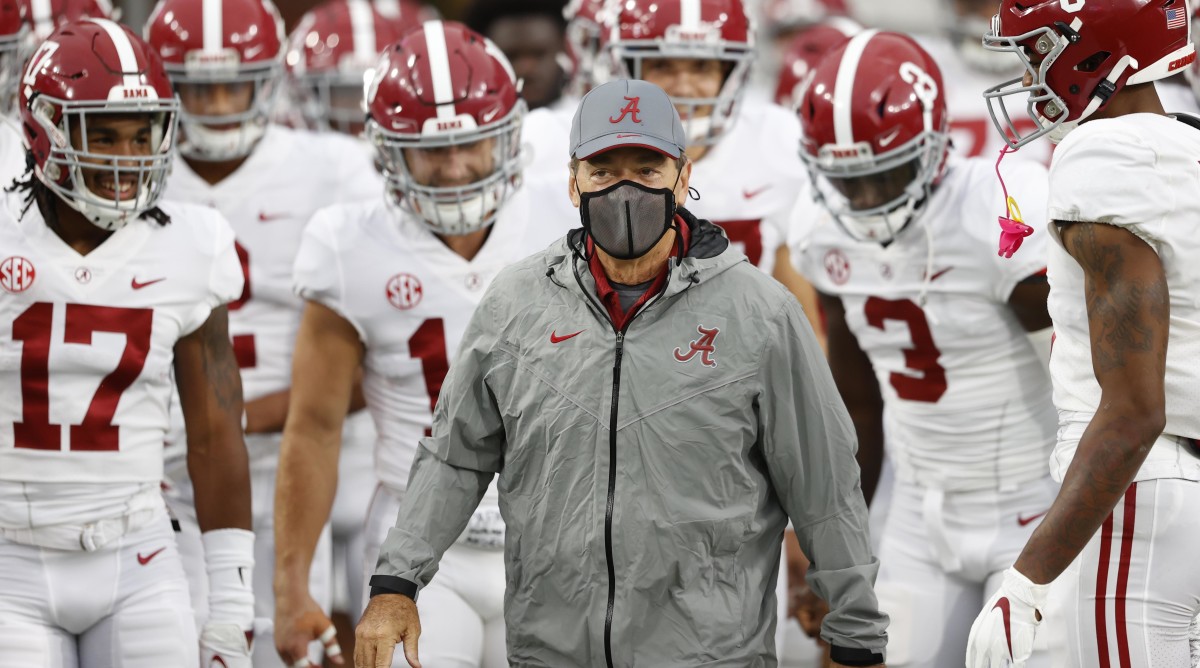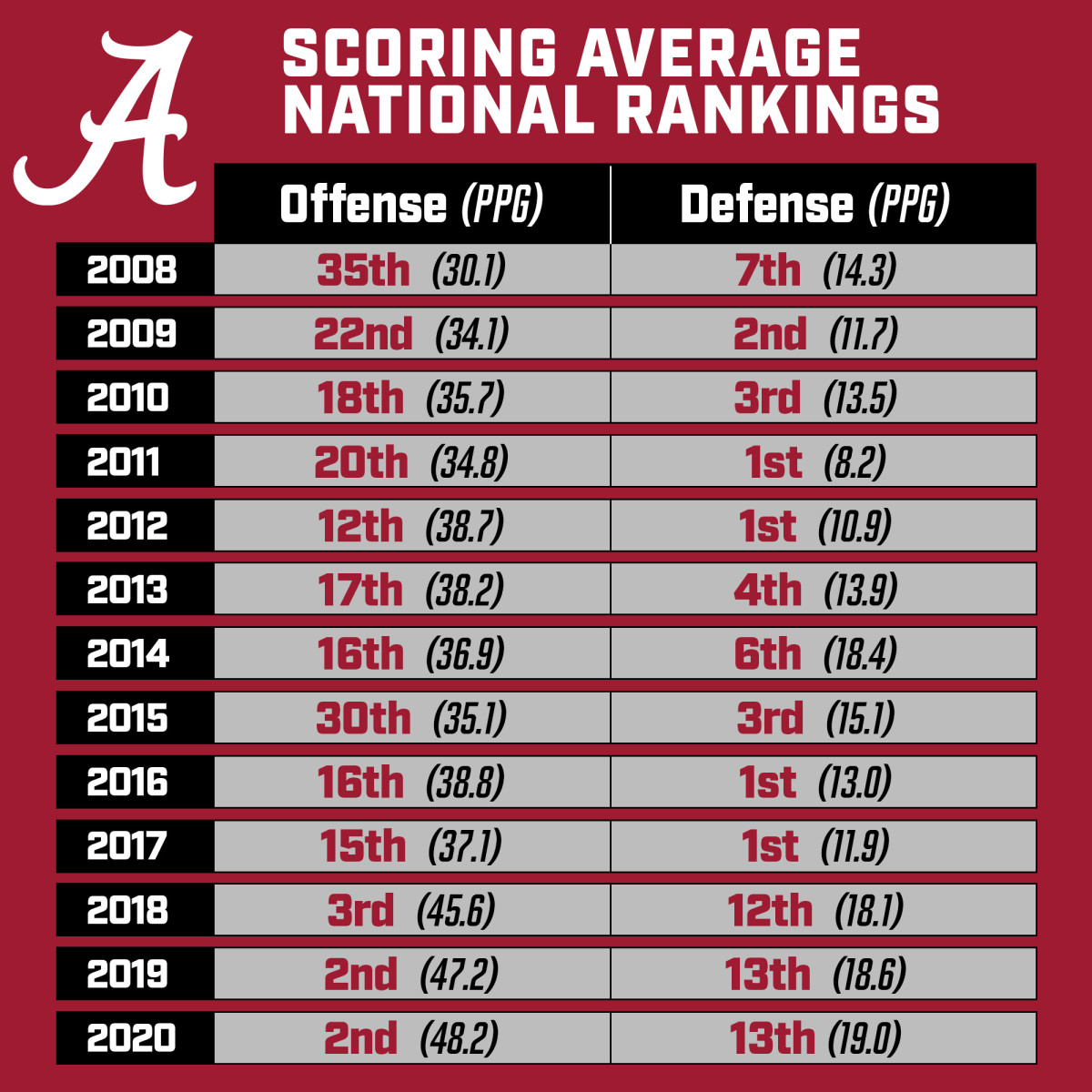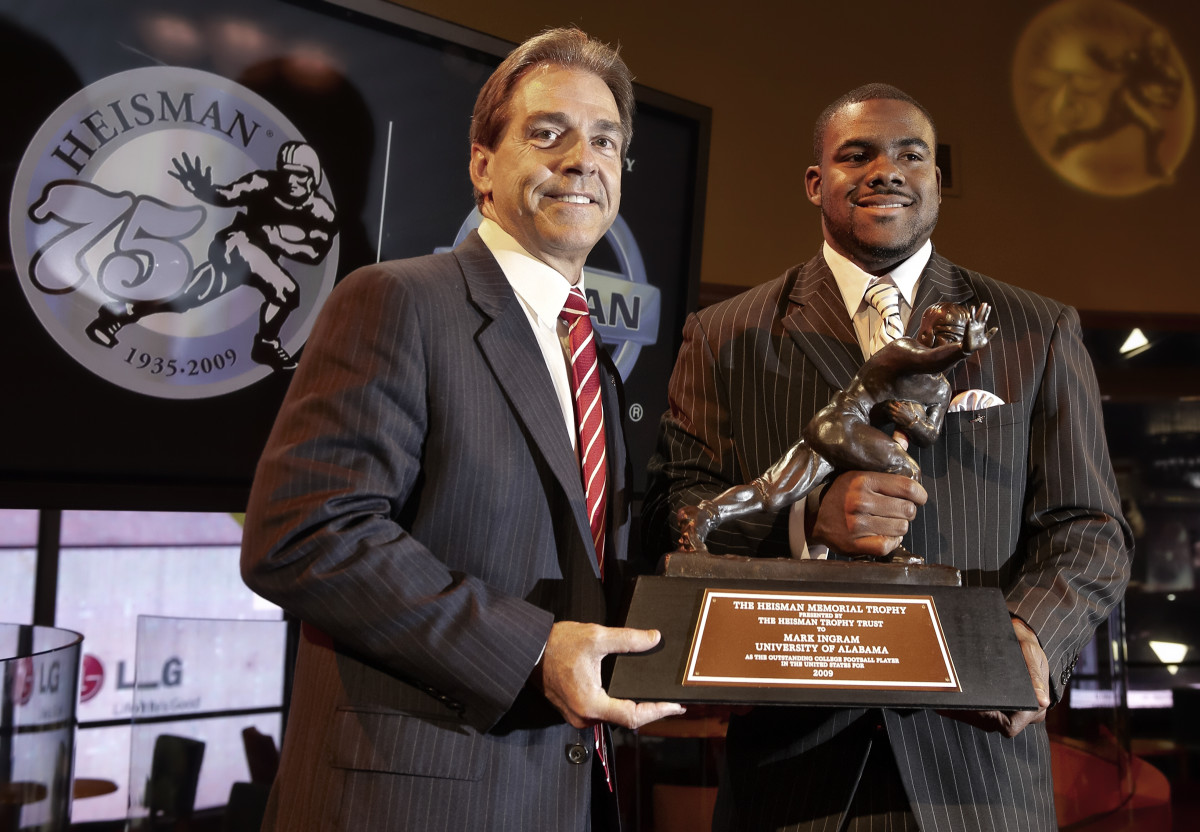The Brilliance of Nick Saban Continues to Evolve
When Nick Saban was 39 years old, he got his first head-coaching job and immediately showed his chops. The Toledo Rockets went 9–2 in 1990, and they were remarkably close to being 11–0.
Their two losses were by a total of five points, both accompanied by offensive struggles and late-game heartbreak. There was a missed 51-yard field goal into a strong wind on the final play in a 13–12 loss to Central Michigan. Then a few weeks later, a Navy go-ahead touchdown with 30 seconds left in a 14–10 defeat. Those Rockets averaged 25.8 points per game; if it had been 26.8, they might have gone undefeated.
Flash forward 30 years, and Nick Saban’s current team is averaging 28.9 points … in the first half. For a full game: 48.2. The greatest defensive coach in the history of college football is culminating a late-career reinvention as the leader of the most potent offense in the game.

“It’s pretty amazing,” said ESPN analyst Greg McElroy, who quarterbacked one of Saban’s many defensively dominant national championship teams. Now he sees an armada of receivers, a second consecutive NFL-caliber quarterback, a dazzling running back and a willingness to throw for nearly twice as many yards as running the ball.
“This is not Pro-I, let’s run it up inside and play great defense,” Notre Dame coach Brian Kelly said of the 2020 Crimson Tide, who overwhelmed the Fighting Irish 31–14 last week. “They’re still playing fundamentally sound defense. You’re still seeing the same principles. You’re seeing at times elite play in certain position groups at Alabama. And now an offense that can rival the very best college offenses in the country.”
It is, for all intents and purposes, the very best offense in the country. The current 48.2 scoring clip would lead the nation if not for the 49.8 points averaged by Kent State in just four games—an average that NCAA Statistics officials said will count as the national statistical champion despite the low number of games played. Alabama would need to score 70 in the College Football Playoff championship game against Ohio State to overtake the Golden Flashes—and while a shootout is expected, that total is highly unlikely.
So due to a pandemic kink in the system, Saban will narrowly miss out on also leading the nation in scoring offense, after leading it in scoring defense five times—four at Alabama and once at LSU. It’s a heck of a twin feat to put on the résumé.
Eight coaches in history have pulled off the career offense-defense double: Red Blaik at Army; Bud Wilkinson at Oklahoma; Chuck Fairbanks at Oklahoma; Bo Schembechler at Michigan; Tom Osborne at Nebraska; Barry Switzer at Oklahoma; Bobby Bowden at Florida State; and Frank Beamer at Virginia Tech. Of that group, three led the nation in scoring offense and defense in the same season: Blaik and Army in 1944; Schembechler and Michigan in ’76; and Beamer and Virginia Tech in ’99. (Neither the Wolverines nor the Hokies went undefeated or won a national title; the Cadets, flush with World War II talent, destroyed everyone.)
While Saban might not get the career double this season, he assuredly will have more chances in the years ahead now that Alabama has become one of the most desirable destinations for offensive talent. The current team is a game away from finishing as the most dynamic offense in Alabama history. That 48.2 average is just ahead of last year’s Crimson Tide, who averaged 47.2 points, which is a smidge better than the 2018 team, which averaged 45.6.
The only programs to average 45 points or more in three straight seasons: Oregon under Chip Kelly and Mark Helfrich (which did it five years in a row from 2009–14) and Baylor under Art Briles from 2013 to ’15. Both those programs rode the cutting edge of tempo offense, before defenses were prepared to counter them. Alabama, which did not have the benefit of sneaking up on the sport like the Ducks and Bears, is about to become the third.
From 2008 to ’17, Alabama was in the top seven nationally every year in scoring defense, while its offense was never higher than 15th. Since then the defense has not been in the top 10—but its scoring offense has been in the top three for three consecutive years. The reversal of program strength is complete.

“I think it was just a matter of time,” Beamer said of Alabama’s metamorphosis. “People are more offensive-minded. They’ve developed that and got it figured out pretty good—using the whole field vertically and horizontally, making you defend all of it. And he’s got the reputation now that it’s one of the places you want to go to try to win a national championship.”
Alabama had four first-round picks last year, all of them offensive players. The Tide could have four to six more this year, with four of the most likely high picks from the offense. The offensive stars flock to Tuscaloosa from around the nation now that Saban has embraced modern strategies on that side of the ball.
“I think he realized seven or eight years ago, with the way things were going as a sport, that offenses could very easily neutralize defensive personnel,” McElroy said. “By making guys think and react, you’re making them just a little slower. Your five-star middle linebacker, if he can’t react quick enough, becomes a three-star pretty quickly. He recognized that you’re going to have to outscore some folks.”
At least partial credit for pushing Saban into the modern era goes to Kevin Sumlin, Gus Malzahn and Hugh Freeze, a trio of rival SEC West coaches who used tempo, run-pass options and spread principles to make life harder for the Tide. Sumlin and Texas A&M upset Alabama in 2012 and scored 42 on it the following season, with Johnny Manziel being a thorn in Saban's side. Malzahn and Auburn beat Alabama in the famous 2013 Kick Six game, and scored 44 on Bama in a losing cause the next year. Freeze and Mississippi upset Alabama in consecutive seasons, 2014 and ’15, scoring 43 points in Bryant-Denny Stadium in the latter.
If you cannot reliably beat ’em, join ’em. And then recruit better players than they have.
“Part of it has to do with branding,” McElroy said. “Recruits gravitate to fast offense. And, really, what’s more fun to watch?”

Ah, but here’s the key question when it comes to Saban: What’s more fun to coach? I asked him Monday—shutout or shootout? Is one more satisfying than the other?
“I don’t think so,” he said. “I think you have to do what you have to do to execute, play well in the game, give yourself an opportunity to win. Every game can have an ebb and flow that can end up being a little bit different, and you’ve just got to end up playing the next play and hope that you can do the things to finish the game … and have a chance to win.”
Sounds good, but really, now. Greg McElroy, if lifetime defensive soul-crusher Nick Saban has a choice between winning 48–43 or 10–7, which one is taking?
“If he had his choice, it’s 10–7, 100%,” McElroy said. “He won 10–7 for 20 years as a head coach. Only in the last five has he been comfortable winning 48–43.”
Saban won his first national championship in 2003, when he was at LSU, with a 21–14 victory over Oklahoma in the Sugar Bowl. That was a defensive slog: The Tigers hammered Heisman Trophy–winning quarterback Jason White and allowed the Sooners just 154 yards of total offense. LSU’s buttoned-down offense ran the ball 40 times, passed it 24 and did just enough to secure victory. One of the Tigers’ touchdowns was scored by the defense.
The second title, at Alabama in 2009, was a 37–21 victory over Texas—but in that game the Tide passed for just 58 yards and had a mere 263 yards total offense. Saban’s defense scored a touchdown in that game, as well, and produced five turnovers, giving its fitful offense short fields.
The third, in 2011, was arguably the ultimate Saban defensive masterpiece. In a rematch with an LSU team that beat the Tide by the Cro-Magnon score of 9–6 in Tuscaloosa, Alabama throttled the Tigers. LSU had less than 100 yards of offense and crossed midfield only once—and that was in the fourth quarter when the game was out of hand.
The fourth came the following season, and it was another defensive takeover. The victim then was Notre Dame, the score was 42–14, and it was 35–0 before the Irish mounted a scoring drive late in the third quarter.
At that point, it seemed like the Saban formula was set in stone: defense, running game, pass when needed for balance, continue to dominate. He’d won four nattys, he was 62 years old—what would be the point of changing anything?
Continuing to win would be the point. The world is full of successful coaches who resisted doing things a different way, even when they became less successful. Then there are the Mike Krzyzewskis and Bill Belichicks and Pete Carrolls who evolve. Nick Saban is firmly in the latter camp—perhaps the best of them all.
“Coach Saban is always willing to keep evolving,” said Alabama athletic director Greg Byrne. “He never stops looking for ways to improve.”
He won a back-and-forth fifth national title 35–31 over Clemson to end the 2015 season, and the following year lost a wild, 45–40 rematch to the Tigers. There was a return to a more classic, Sabanesque title game in the 2017 season, when Alabama beat Georgia 26–23 in overtime, then a full-system-failure loss to Clemson in the 2018 title game.
This time, against Ohio State and hotshot offensive coach Ryan Day? It won’t look anything like the 21–14 title slog, or the 21–0 strangulation. The established Las Vegas total on the game is 75, with Alabama favored by eight. So the bookies are betting on something in the neighborhood of Crimson Tide 42, Buckeyes 34.
That’s a long way from losing games 13–12 and 14–0 three decades ago. But it really is the same Nick Saban, a brilliant coach willing to do things very differently when the times demand it.
